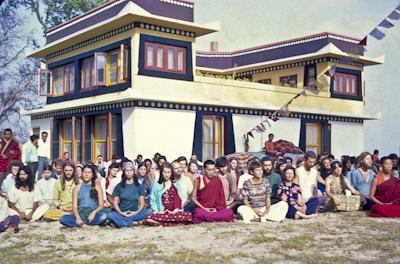The five paths to omniscience are the Mahayana path of merit, the Mahayana path of preparation, the right-seeing Mahayana path, the Mahayana path of meditation and the Mahayana path of no more learning. When you generate bodhicitta effortlessly you have entered the Mahayana path.
Within the first Mahayana path, the path of merit, there are three divisions: lower, middle and greater. The first Mahayana path is the accumulation of merit. That is the literal meaning. The second path is when you have achieved insight, the wisdom realizing emptiness. Then, you have achieved the path of preparation, which has four divisions. The initial meaning of the Mahayana path of preparation is about working in order to fully see the meaning of selflessness, without any deception.
Whenever you generate the wisdom of fully realizing emptiness, your mind approaches the right-seeing path, the third path. You have the wisdom to fully see the meaning of selflessness, emptiness. Then, the next stage is the Mahayana path of meditation, where the wisdom that you have generated before, fully seeing emptiness, is developed by continuously training the mind. Then, when all the disturbing-thought obscurations and all the obscurations to knowledge are both completely removed, there is no need for further training, and you have achieved the path of no more learning.
According to the path to nirvana for the individual liberation practitioner, when you have generated the thought of renouncing samsara, at that time you enter the Lesser Vehicle’s path of merit. The thought of renouncing samsara is the door of the path to nirvana. If you only generate the thought to renounce samsara, without the thought of bodhicitta, then you enter the path of the individual liberation practitioner. When you effortlessly generate the thought to renounce samsara and bodhicitta together, then you have attained the Mahayana path.
You can experiment on the mind, just as a scientist does on external phenomena. You can understand it with your own experience. All the confusion and world problems come from the unsubdued mind. Not having a subdued mind is the whole problem. Everything that the Buddha said in all the five great treatises, everything that Buddha ever explained, is the method to subdue the mind. He did not explain it just to calm the mind. It was not just to write books, not just to show he was very learned and a great scholar. The whole Sutrayana teachings are to subdue the mind, to improve the mind, because the unsubdued mind is the whole problem.
Scientists examine things. They count the numbers of things, to try and learn things—how many people in the mountains have big heads, how many stones are in this country, how many birds are in that country. No matter how much they examine things and how many numbers they know about external phenomena, it cannot subdue the mind. It is more profound to examine the mind than to examine external phenomena. By examining the mind you can understand better and be clearer about the nature of the external phenomena. No matter how much scientific progress there is, inner peace doesn’t increase in the minds of the humans in the world. Even in the country where there are the greatest scientific discoveries, there is no more inner peace. That is mainly because what is missing is the method, the practice to subdue the mind. Even though you learn so much about external phenomena, the practice to subdue the mind is still missing.
Therefore, you should attempt to practice meditation; you should seek enlightenment for the benefit of all sentient beings, not only for your own happiness, for nirvana, but for the happiness of all others. If you have that aim, you should make an experiment about the thought of liberation from samsara, bodhicitta and the wisdom realizing emptiness. When you generate each of these realizations, is there greater and greater peace? When each of the wrong conceptions is eliminated in the unsubdued mind, when all the conditions are perfect, you should experiment on these three principal paths to enlightenment. When you do, you are making an experiment on something you have never done in any of your past lives, from beginningless past lives until now. There is nothing more worthwhile in the world to do. What else can you do? What is the most precious thing you can do in the world? What is there in the world that gives greater benefit for others, even for yourself? Nothing.
Just watch everybody in the whole country; watch the people’s minds. Whatever they do, they are just repeating what they have done numberless times, just repeating on and on. Their minds are completely confused. Going for a holiday, working, whatever they are doing, they don’t know what they are doing. They don’t know what the best thing for others is.
In this life, if you are able to make an experiment on the three principal aspects of the path, that’s great. Even if you just want to benefit yourself, that is good. But if your concern is for other sentient beings, that is the doorway to give extensive benefit to others.
So, without wasting time, without being lazy, it’s time to have a long-term plan, even though you might find the subject unclear and hard to understand now. It takes time to learn the ABC all the way up to Z. It takes time to understand the Dharma and generate realizations. This is the hardest work! It is the most profitable work but it is the hardest work of all. So far, you have been overwhelmed. Since beginningless time until now you have been unable to eliminate your delusions but now, at this time, you are able to face up to them and not be overwhelmed. So, of course, it is the hardest thing. By knowing this, it is extremely important to have a long-term aim and be prepared to practice for a long time in spite of the difficulties.































